Archive for August, 2017
Sustaining local agriculture for economic growth
Their work and stories intrigued him, ignited his passion for agriculture and led him to study agricultural economics in the United States, which changed the course of his career.
“Agriculture brought me to real people and their problems,” said Rimal, a professor of agriculture and interim department head of agribusiness, education and communication in the Darr College of Agriculture at Missouri State University.
His research interest is in applying economic theory in the food industry from both production and consumption perspectives. His accounting and finance background is an asset as he works to advance agriculture and economic growth in Missouri.
“In recent years, I’ve been working on the area of locally grown produce,” said Rimal, who has received more than $700,000 in external grant awards for his research.
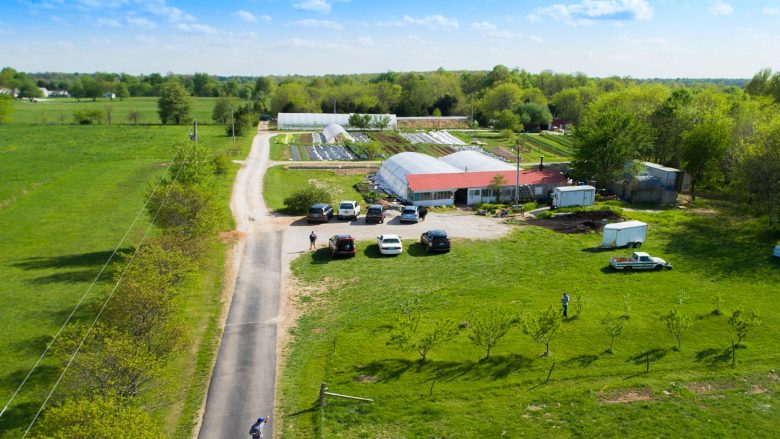
An aerial shot of Millsap Farms, a family-owned 20-acre farm in Springfield, Missouri. Photo by Bob Linder
Establishing a food hub
His latest project impacts farmers directly as he explored how to get produce from a farmer’s field into a consumer’s hands more efficiently by studying the feasibility of setting up a food hub – a marketplace that connects farmers (producers) with professional food buyers, such as schools and grocery stores, and end consumers – in southcentral Missouri.
Funded by the United States Department of Agriculture Rural Development program, the project took more than a year to complete as Rimal and his team of two graduate assistants, Jennifer Muzinie and Jennifer Moldovan, interviewed 163 producers and 101 buyers in the region.
“There’s a national recognition of supporting food hubs as they can really help rural development because a lot of producers are in the rural area and they have challenges marketing their product,” said Rimal. “We wanted to see whether a food hub will stimulate the economy in this area, whether buyers are willing to buy from it and producers are willing to supply to it.”
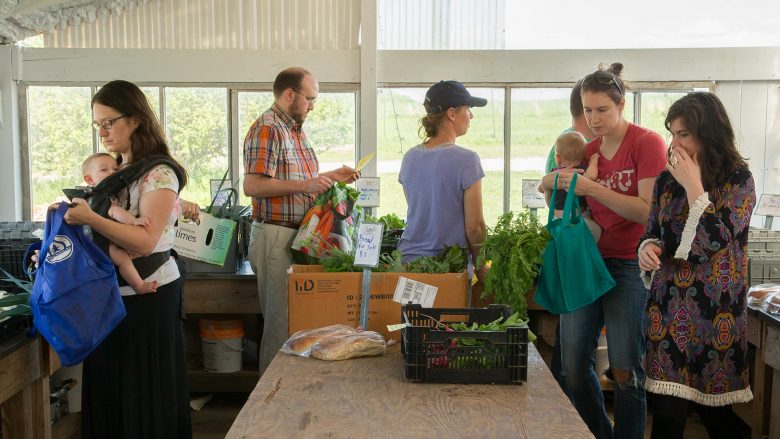
Participants of the community-supported agriculture program at Millsap Farms select produce. Photo by Bob Linder
What do producers and buyers want?
So is a food hub feasible in this region? Absolutely, according to the findings of Rimal’s study.
“There’s a huge demand for locally produced food and buyers are willing to buy locally grown vegetables and livestock products and pay a premium for them as long as producers comply with certain requirements, such as food safety, consistency in delivery and traceability,” said Rimal.
As for the producers, the majority of them expressed interest in selling through a food hub. Of course there are challenges, such as investment of time and money to comply with buyers’ requirements or use more technology for year-round yield, Rimal noted, but he believes the benefits of a food hub outweigh the costs.
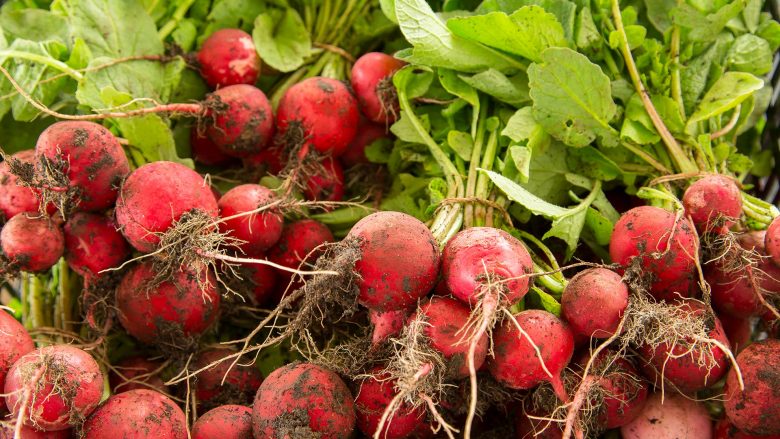
The benefits
For farmers, a food hub means less waste, greater productivity, assurance of sales and time savings.
“They don’t have to sit at a farmers market the whole day and spend their time marketing as somebody else is doing that for them,” said Rimal.
For consumers, a food hub offers easier access to a larger variety of fresh healthy foods all year long and the opportunity to support local and regional food systems. This means they contribute to environmental sustainability.
“We don’t have to eat produce that’s coming from thousands of miles away from another country,” said Rimal. “We can help improve the lives of local farmers and decrease our own carbon footprint.”
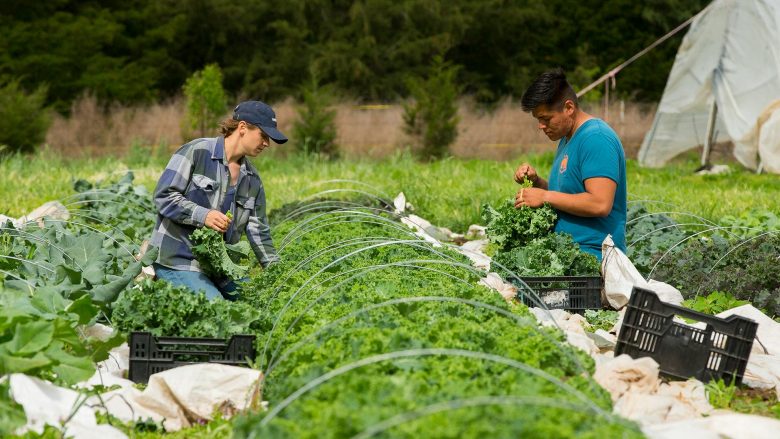
Farmers harvest produce at Millsap Farms. Photo by Bob Linder
Moving forward
He and his team have presented this research not only in the United States but also in Europe at the International Food and Agribusiness Management Association World Conference 2016 in Aarhus, Denmark.
“I’m excited about using my knowledge and technical skills in an area where it really matters. This kind of stuff has real meaning for people at the grassroots level. It can impact people’s lives.” — Dr. Arbindra Rimal
Moldovan, who interviewed a lot of the buyers, presented her part of the research at the conference. She said working on the project was a learning experience as she did not know much about food hubs going in.
“Probably the most interesting thing we found through our data was the overall acceptance of local because sometimes you don’t think bigger companies and institutions even really care,” said Moldovan. “But doing the research, we found out the different ways they are trying to support local even if they are not able to purchase because of all the regulations.”
Based on the positive findings from the study, Rimal said he is ready to continue working on making the food hub a reality. He has asked the USDA Rural Development program to fund the next part of the research, which involves developing a detailed business plan.
“I’m excited about using my knowledge and technical skills in an area where it really matters,” he said. This kind of stuff has real meaning for people at the grassroots level. It can impact people’s lives.”
- Story by Emily Yeap
- Photos by Bob Linder
- Video by Chris Nagle
Further reading
Protein packs a powerful punch in studies of cell processes
As a biology professor, Kim is interested in studying cellular processes that have the potential to one day better explain disease progression. Dynamin is a tie that binds his four studies together.
Internal recycling
In the body, some plasma membrane proteins are internalized via small sack-like vesicles formed at the plasma membrane. Then, they’re delivered to internal membrane-bound organelles prior to exiting these organelles again until the proteins are degraded. This is biomolecule recycling, one interest of Kim’s.
Using budding yeast, Saccharomyces cerevisiae, as his model due to its two-hour reproductive cycle, Kim has been studying how this recycling is affected by fat change, like with cholesterol. In one study, he changed the fat levels and noted that proteins were no longer internalizing, and therefore, not recycling.
“Then we deduced, ‘Oh, this increased level of fat caused a defect in the recycling process of this biomolecule,’” said Kim.
This conclusion has led him to further studies to identify which genes and molecules are actually involved in that process.

Kim uses a confocal microscope – purchased with grant funding from the National Science Foundation – and fireflies to see these tiny proteins.
Building blocks
Like humans, cells have to eat and drink in order to stay alive and active; this cellular eating process is called endocytosis. The goods are delivered to the lysosome, or cell’s stomach, and are degraded into building blocks like sugars, amino acids and fatty acids. Those nutrients eventually assist with the building of cells.
Kim notes that more than 500 proteins are serving as “work horses,” working in tandem for the efficiency of endocytosis. One of those proteins is dynamin (VPS1), which Kim discovered is implicated in pinching up the vesicles during endocytosis.
But dynamin, like the root of the word suggests, is a powerful thing. It has the ability to play many roles in the body.
“Dynamin consists of multiple domains or parts. Proteins have multiple parts, like humans have heads, legs, feet and hands,” said Kim. So he and his students are trying to identify whether it’s the proverbial head or foot of dynamin that is playing these roles.

Photo by Jesse Scheve
Traffic studies
Dynamin is also involved in his third study – a study of the traffic in the body.
“Inside your body, cells are what’s considered a mega city, probably bigger than mega city when you compare it to human society. Within the cell we have a lot of stations, like membrane bound organelles,” said Kim.
He explains that there are round-trip traffic pathways between the hundreds of stations.
“If you have a cell that was expressing or harboring some mutant form of police officer regulating traffic, what happens? Pandemonium,” he said, noting that in this example, the police officer would be a protein. “If your cell is expressing a mutant form of traffic protein, such as dynamin, then maybe you actually end up with Alzheimer’s disease.”
As in his other studies, Kim is wanting to identify which part of the dynamin is responsible for this change. Though his study is of yeast, he knows that his findings could be built upon and inspire a major medical breakthrough.
“In his research he studies these events in yeast, which is an ideal model organism to study how our own cells move molecules,” said Dr. Paul Durham, director of Missouri State’s Center for Biomedical and Life Sciences and distinguished professor of biology. “His findings have implications for understanding several human disease processes including several neurological diseases.”
Another interest for Kim is the possible toxic effect of nanomaterials and the affect they may have on human cell growth. To study this, he’s been using a technique called cell culture and measuring the densities of cells. If the nanomaterials are toxic, a cell will not grow. He’s also been collaborating on several research projects looking at carbon nanotubes as well as silver and cadmium.
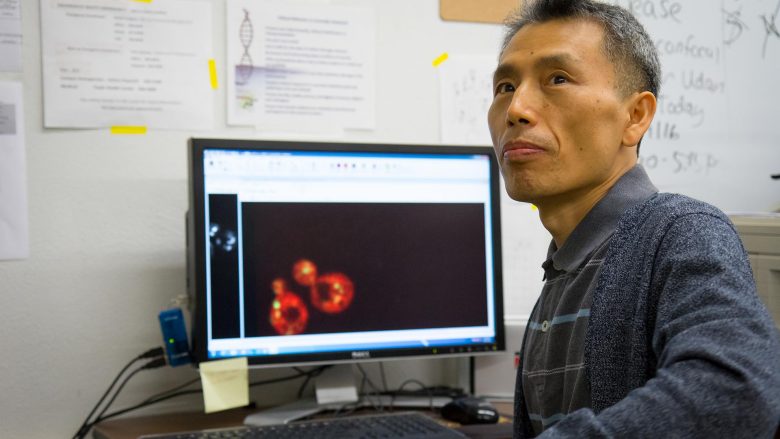
Connections
“Basically all four topics are all connected. In order for protein biomolecules to be internalized during recycling, cells have to use the method called endocytosis,” said Kim. “Then, the delivery between the cell’s stomach and the shipping and handling place requires traffic. Nanomaterials not only exist outside of the cell but also they can be internalized into the cell and targeted to specific organelles which they negatively affect.”
Kim’s research – much of which has been produced in conjunction with undergraduate and graduate students at Missouri State – has been published in journals like Journal of Cell Biology, Journal of Nanotechnology, Journal of Bioscience, International Journal of Science and Technology, Nanoscience and Nanotechnology and Biochemistry and Cell Biology.
In addition to Kim’s exemplary research program in cell biology, Kim was honored with the 2015-16 Governor’s Award for Excellence in the Teaching. This award is only given to one faculty member from each of the state’s public universities.
- Story by Nicki Donnelson
- Photos by Bob Linder
- Video by Chris Nagle

